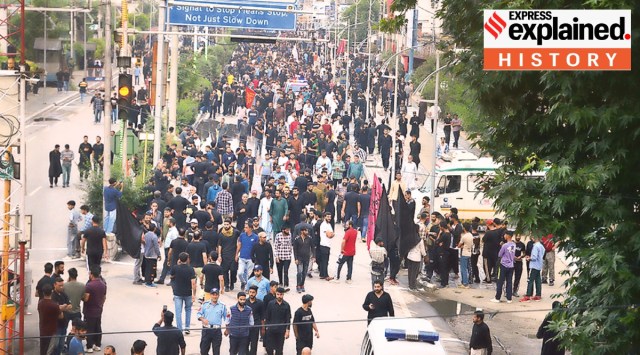The decision to allow the procession on the 8th of Muharram (which is the first month of the Islamic year that began on July 19 this year) has been hailed; it has also spurred demands for lifting the ban on the main Ashura procession on the 10th Muharram (which will be observed on July 29) as well.

Shia Muslims around the world take out Ashura processions to commemorate the martyrdom of Imam Hussain, a grandson of the Prophet, who was killed in the Battle of Karbala (680 AD; 10 Muharram 61 AH) in present day Iraq.
Restrictions on Muharram processions under Dogras
While the Dogra rulers of Jammu and Kashmir either prohibited Muharram processions or allowed them only at night, the recent ban started with the beginning of militancy in the erstwhile state.
In the 1920s, the Dogras ordered that Muharram processions should be wrapped up before sunrise, citing “Shia-Sunni tensions”. In 1924, mourners defied the order and marched during the day and, according to author Hakim Sameer Hamdani, were joined by Sunnis as well. The procession went to the Imambara in the Zadibal neighbourhood of old Srinagar, and culminated at the Sunni shrine in Narwara.
“The main architects of this procession were Khwaja Saad-ud Din Shawl, a prominent Sunni merchant, and Aga Sayyid Hussain Jalali, a Shia jagirdar,” Hamdani said. “This procession also became associated with the Muslim freedom struggle in Kashmir against Dogra rule.”
After Shia mourners petitioned the Dogra rulers, permits to take out processions were issued to certain individuals such as the Shia businessman Haji Kaloo, the family of the Shia cleric Iftikar Hussain Ansari, and the Aga family of Budgam.
Story continues below this ad
Both Shias and Sunnis
Muharram processions in Srinagar traditionally started at Namchabal and ended at Zadibal in the old city. Sheikh Mohammad Abdullah insisted that the main procession on the 10th Muharram should start from Abi Guzar in the centre of Srinagar city, pass through the old city, and culminate at Zadibal.
Sheikh Abdullah also insisted that the Ansari family and the Aga family of Budgam should lead the procession in alternate years. As the procession passed through the city centre, it would be addressed by Abbas Ansari of the Ittehadul Muslimeen, a political rival of Iftikar Hussain Ansari.
Since Ansari and his Ittehadul Muslimeen believed in reconciliation with Sunnis, a large number of Sunni mourners too joined the procession.
After militancy began
The Muharram processions continued on their traditional routes for several decades. In 1988, the government declined permission as Muharram coincided with the death of Pakistan’s President Gen Zia-ul-Haq, which triggered protests in the Kashmir Valley.
Story continues below this ad
After militancy began, the government banned the main Muharram procession in Srinagar, even though smaller processions continued to be taken out in the Shia-dominated areas of the city.
Mourners led by Abbas Ansari and his son Masroor Abbas defied government orders and continued to take out processions on the 8th of Muharram from the Shaheed Gunj area of the city. With police imposing curfew and restrictions, the processions would culminate in pro-separatist protests. The Ittehadul Muslimeen was a constituent of the separatist Hurriyat Conference — Abbas Ansari himself was chairman of the Hurriyat — and the government feared the processions would turn into violent pro-Azadi protests.
While the ban on Muharram processions was imposed during the tenure of Governor Jagmohan, successive governments, acting on advice from security agencies, continued with the policy.








































